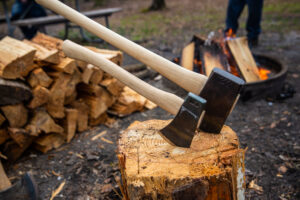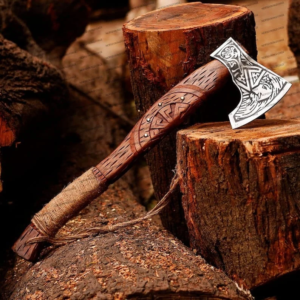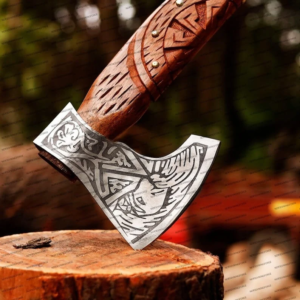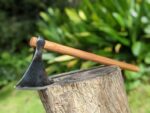A hand forged single-handed Viking broad axe. This is a sharp-edged cutting tool ready for use.
ITEM DETAILS
A mild steel head with high carbon steel cutting edge forged using traditional techniques. The cutting edge has a 20 to 25 degree ‘V’ shaped bevel and is approximately 5″ (13cm) long. The handle is approximately 20″ (51cm) long and is made of Tasmanian Oak hardwood. The total weight of the handle is approximately 1 lbs (470g).
This axe is ideal for the Viking reenactor or early medieval collector/enthusiast.
HISTORICAL REFERENCE
This design is based on broad axe archeological finds from around AD 940 to AD 1050 which are commonly classified today as Petersen Type “M1” axes. They all have broad curved cutting edges with curving profiles that narrow to a twin-spurred handle socket. This is truly an iconic Viking axe.
This type of axe was mostly likely used as a single-handed weapon but could also be used as a cutting and woodworking tool. It is small enough to be worn in a belt or carried strapped to a pack.
PRODUCTION PROCESS
A traditional forging process was used to create this axe. The head was forged from a single piece of mild steel with a piece of high carbon steel forge-welded onto the end to form the cutting edge.
Hardenable carbon steel was a precious commodity in the Viking age and was used sparingly. Whether intended or not, this process produced axes with a hard and sharp cutting edge that could absorb the force of repeated blows without breaking.
As a hand-forged item, you will find this axe has an individually crafted beauty and personality to it. The axe head retains some of its dark coloring from the heat treatment process, i.e. oil quenched for hardening and tempered to gain toughness. You may also notice faint evidence of the forge-welding process, present on archeological finds, which is in no way a point of weakness on the axe body.
The handle has been finished with linseed oil and firmly secured to the axe head using a wooden wedge.






























Reviews
There are no reviews yet.